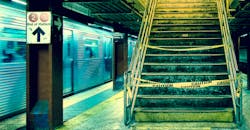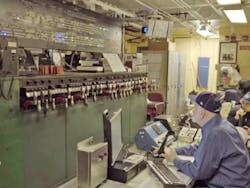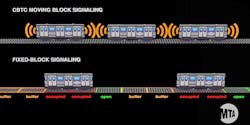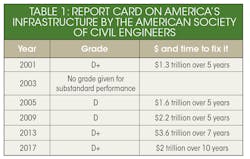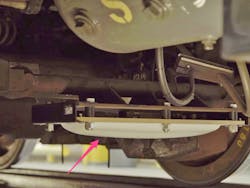New York City's Subway a Metaphor for the Nation's Infrastructure
To take part in the Machine Design infrastructure survey, click here.
Anyone that has visited New York City has probably used its subway. It is one of the oldest and most used subways in the world. This means when there are small or large mistakes the consequences pile up fast. To manage this gargantuan task, you might imagine the city uses only the latest cutting-edge technology. However, this is not the case. Much of today’s subway system is about as old as the subway itself.
Not only are parts old, but some can’t be ordered anymore. Technicians sometimes have to make or scavenge for parts to keep the trains running. This would be a perfect application for 3D printing, but you’re talking about a system that still uses a pen and paper for many of its operations.
The New York Times reported that in 2012 the MTA had about 28,000 delays a month, and today there are 2.5 times that, about 70,000 per month. Gov. Andrew Cuomo is desperate. Like bridges and tunnels and roads in most of America, the subway’s infrastructure is crumbling, and those in charge don’t know how to fix it. Fortunately, admitting you have a problem is the first step to solving it. Step two is admitting you need help.
“It is no secret the New York City subway system is in dire need of upgrades and repairs, not only for the safety of commuters and visitors throughout the metropolitan area, but in order to meet the demand of travelers as ridership continues to grow,” says Cuomo. “With the launch of [the] MTA Genius Transit Challenge, we will draw some of the greatest minds from across the globe to the Empire State to help inspire forward-thinking, innovative ideas that will usher in a new era of mass transit for New York that ensures the safety and efficiency of travelers today and tomorrow."
Those participating will need to address three specific areas:
* Address the aging signal system in a faster and more efficient way to enable the MTA to expand the number of trains per hour during peak periods.
* Address the subway system’s aging cars. Strategies can include the refurbishment of current subway cars, upgrading existing systems, better maintenance programs/protocols, and faster delivery of new cars.
* Design communications technology for cellular and WiFi connectivity that can be installed throughout the entire subway system including tunnels.
Communication based train control (CBTC) tracks train movement precisely on a secured WiFi signal. Software is able to calculate how close and fast the trains can follow each other. If a leading train slows on approaching a station, the following train will automatically brake to maintain a safe following distance.
Cuomo is taking a page from the maker movement to launch this hack-a-thon to save New York City’s subway. Corporations use hack-a-thons or make-a-thons to bring people all over the globe together to find solutions. Most of the ones I’ve attended have tried to get me to sign NDAs and legal paperwork surrendering any ideas generated in the event (tip: if you push back a little they tend to let you participate without signing your brain away). These challenges are so popular that NASA started a Space Apps Challenge in 2012. Recently, NASA’s challenge had over 25,000 people participate in over 187 locations.
Could this grassroots engineering be a way to turn America’s infrastructure around?
Recently the American Society of Civil Engineers published its report card on how America’s infrastructure is doing. It’s been a while since we have received exemplary marks, and this year’s report continued the trend. (Click here for the full report.)
“Good infrastructure allows us to be competitive in the world,” says Greg DiLoreto, chair at the ASCE committee on American Infrastructure. There has been plenty of talk recently about President Trump’s infrastructure plan to spend $1 trillion over 10 years, but according to the ASCE this is half of what is needed. Since New York’s subway is a perfect example of a large old system trudging along, hopefully it can also be an example of how to bounce back and find innovative solutions.
The New York City subway has about 1.8 billion riders per year, making it the seventh most traveled in the world. This means it needs both quick and long-term solutions. One solution being implemented is to replace the signal system with transponders. This will be the first time this has been updated in over 90 years. The transponder shows exactly where the train is and provides an automatic braking system to prohibit the train from crashing into each other.
Here is one of the transponders that will eventually replace the current signal system.
This lets trains run at faster speeds and closer together, increasing the number of trains on the rails by about one third. This also can give more accurate information when trains are arriving and departing stations. Having real-time data can let subway users decide the best way of getting from point A to B. This could prevent passengers from getting anxious or angry on crowded platforms waiting for trains that may or may not be coming.
Delays and problems are inevitable, but the United States has historically avoided many of the infrastructure issues, or found ways to patch them. This approach has even been given a name; Department of Transportation workers have called this approach “patch and pray.” We have done this for too long. Do not accept excuses–remember for the same amount of money the MTA spends on the NYC subway, we sent a mobile science laboratory to Mars.
If scientists and engineers can accomplish this, we have to be able to get people to Times Square–even with a laggard government. Engineers build this country, it is time for us to pull the government’s head out of the ground, and elsewhere. Contact your local representatives (click here to find your local reps in NYC, or other areas) and host make-a-thons. Bring engineers together to discuss some of these problems. Have your group of engineers communicate with the local governments to know the local challenges. I never thought engineers would have to start a grass-roots movement for the thing that keeps this nation alive, but here we are.
In the spirit of not just complaining, but offering solutions, I’ve put together my own ideas that might help Gov. Cuomo.
* To address the aging signal system: Use technology like the CBTC, but take it a step further. Why move thousands of people in one large train? This requires a large space to load and unload on. Then that prime real estate sits empty just a few minutes after the train leaves the station.
We already have the technology to have trains operate autonomously—for example, the AirTrain at JFK. Now let’s divide and conquer—train cars already have individual motors and power connections, so we can run shorter trains. Having self-driving small trains would keep a small train in the station at all times, or close to it. With the longer platforms there could be a separate unloading section and loading section. Trust me, if you are from New York City, the idea of letting people off before getting on is like rocket science when dealing with the masses.
A lot of time is spent getting into and out of the train due to people blocking the doors or pushing into the train before people have had a chance to exit. Separate sections could greatly decrease the amount of time need to load and unload. This will obviously not be possible at all stations, and might be more of a problem. However, knowing another train will be along in a minute might reduce the anxiety of the people on the platform. This psychological effect might improve loading and unloading time on its own. Decreasing waiting times will ease anxiety, anger, and perhaps keep passengers from pushing and shoving onto the train. Not knowing when the next train is, or knowing the next one is in 10 minutes or more can make even a level-headed person push their way into an already packed train.
In addition, when a train unloads it’s only a couple hundred people that need to fit through the halls and stairs. This eliminates the crowded stairs and will help people get into and out of the subway station more efficiently. Knowing a train is in the station, or only a couple of minutes away, will stop people from running and potentially hurting themselves or others.
This is great for MTA employees. If the TWU Local 100 is worried about automation taking jobs, there are options. Each smaller train could be outfitted with a platform technician to help anyone physically handicapped getting on and off the train, provide safety, basic first aid, or just be along for the ride to place a call to an emergency response unit.
* To address the subway system’s aging cars: This upsets me—why aren’t they experimenting with hydraulic hybrids in the subway? New York City is already teaming with Bosch Rexroth Corp to use this technology in its garbage trucks, why not the subway? There are a lot of differences, but regenerative braking can reduce fuel consumption by 30% to 50% in garbage trucks. UPS is already using this technology. Electricity is a limited resource in New York. Imagine the power put back on the grid if the subway way ran 30% to 50% more efficiently.
The maintenance might also be reduced as the hydraulic system is relatively simple. Fixes would be quick and cheap, as there aren’t a lot of parts. Also, if the smaller autonomous train design was used, cycling cars in and out of service would be seamless.
* To design communications technology for cellular and WiFi connectivity that can be installed throughout the entire subway system including tunnels: Instead of installing a hub in every part of the subway, why not use the cars themselves? Again, if we use the small train model, there should never be a train too far away from another. The close proximity could relay signals to a hub at a station or somewhere where it can get to an outside connection.
This connection will ensure real-time data from the trains, and passengers could use their electronic devices en route. The best part of having a wireless hub on the train is now the MTA can use the Industrial Internet of Things to better manage maintenance on cars. This means pulling a car into maintenance in a planned manner when needed, and if nothing is wrong, it can stay in operation. Tracking this data over time will help engineers lay out tracks, and design future train cars better to minimize maintenance. This further promotes the second element of this challenge to promote the handling of current and future trains.
Yes, I’ve had a lot of time stuck in subway to think about this, and I have many more thoughts. Let me hear how you would fix New York City’s subway in the comments section or email me at [email protected]. Sign up for more information here. The governor’s office is holding a conference on June 29 at the City College of New York. At this conference there will be more specifications and background information shared with participants.
Be sure to participate in our Machine Design infrastructure survey by clicking here now.
